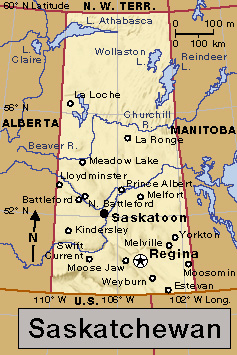Saskatoon << `sas` kuh TOON >> (pop. 266,141; met. area pop. 317,480) is the largest city in Saskatchewan and a major trading center of western Canada. The city lies on the South Saskatchewan River in the middle of the prairies of western Canada.

Settlers from Ontario founded Saskatoon in 1883. They chose the site because the river there made it ideal for ferry and steamboat traffic. The settlers named the town for a berry that grows along the banks of the river.
Saskatoon covers 88 square miles (227 square kilometers) on both sides of the South Saskatchewan River. Eight bridges connect the two parts of the city. Saskatoon’s metropolitan area covers 2,264 square miles (5,864 square kilometers).
The Western Development Museum in Saskatoon features one of the largest collections of antique cars, early farm equipment, and steam engines in North America. The Civic Conservatory houses displays of various plants. SaskTel Centre (formerly Credit Union Centre) is a large arena that hosts sporting events, concerts, and trade shows. Several sites related to the North West Rebellion of 1885 are near the city (see North West Rebellion).
Saskatoon is the home of the University of Saskatchewan. The university ranks as the largest employer in Saskatoon.
Saskatoon serves as the trading center of a farming region of about 70,000 square miles (180,000 square kilometers). The major highways of the region meet in Saskatoon, which is sometimes called the Hub City. Saskatoon’s leading industries are food processing and such technological activities as the development of computer systems and electronic equipment. The area has some of the world’s largest potash deposits, and uranium mines are north of the city.
Indigenous (native) Cree people lived in what is now the Saskatoon area before white people first arrived there in 1883. That year, 35 members of the Temperance Colonization Company settled in the area. The settlers, led by John Lake, came from Ontario. They founded Saskatoon, but they failed to achieve their goal of banning alcoholic beverages from the community. The Canadian Pacific Railway reached Saskatoon in 1890. The city’s population reached about 5,000 in 1906, when Saskatoon was incorporated as a city.
During the 1930’s, dust storms and the resulting crop failures caused great hardship in Saskatoon. Mining of the potash deposits near the city began in the early 1950’s. During the 1960’s, Saskatoon became an important supply center for Saskatchewan’s mining industry, and new factories provided hundreds of jobs for the city’s workers.
In the mid-1970’s, the Canadian government built an oilseed and grain product development center on the University of Saskatchewan campus. The plant went into operation in 1977. Saskatoon has a council-manager form of government.
For the monthly weather in Saskatoon, see Saskatchewan (Climate).
